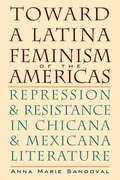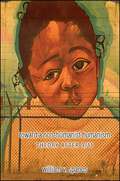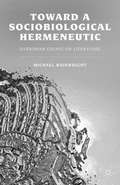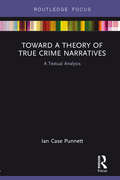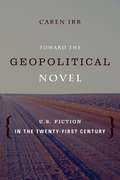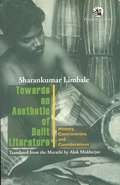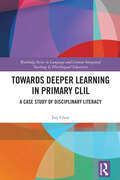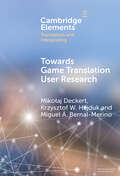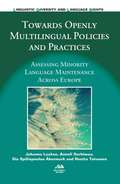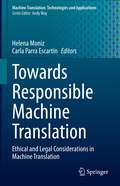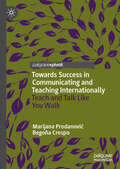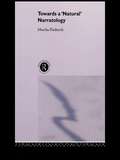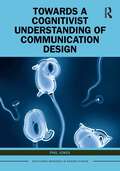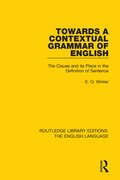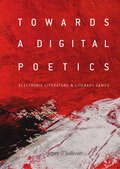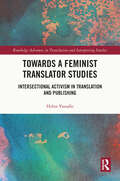- Table View
- List View
Toward a Latina Feminism of the Americas: Repression and Resistance in Chicana and Mexicana Literature
by Sandoval Anna MarieWeaving strands of Chicana and Mexicana subjectivities, Toward a Latina Feminism of the Americas explores political and theoretical agendas, particularly those that undermine the patriarchy, across a diverse range of Latina authors. Within this range, calls for a coalition are clear, but questions surrounding the process of these revolutionary dialogues provide important lines of inquiry. Examining the works of authors such as Sandra Cisneros, Laura Esquivel, Carmen Boullosa, and Helena María Viramontes, Anna Sandoval considers resistance to traditional cultural symbols and contemporary efforts to counteract negative representations of womanhood in literature and society. Offering a new perspective on the oppositional nature of Latina writers, Sandoval emphasizes the ways in which national literatures have privileged male authors, whose viewpoint is generally distinct from that of women-a point of departure rarely acknowledged in postcolonial theory. Applying her observations to the disciplinary, historical, and spatial facets of literary production, Sandoval interrogates the boundaries of the Latina experience. Building on the dialogues begun with such works as Sonia Saldivar-Hull's Feminism on the Border and Ellen McCracken's New Latina Narrative , this is a concise yet ambitious comparative approach to the historical and cultural connections (as well as disparities) found in Chicana and Mexicana literature.
Toward a Non-humanist Humanism: Theory after 9/11
by William V. SpanosIn his book The End of Education: Toward Posthumanism, William V. Spanos critiqued the traditional Western concept of humanism, arguing that its origins are to be found not in ancient Greece's love of truth and wisdom, but in the Roman imperial era, when those Greek values were adapted in the service of imperialism on a deeply rooted, metaphysical level. Returning to that question of humanism in the context of the United States' war on terror in the post-9/11 era, Toward a Non-humanist Humanism points out the dehumanizing dynamics of Western modernity in which the rule of law is increasingly made flexible to defend against threats both real and potential. Spanos considers and assesses the work of thinkers such as Giorgio Agamben, Alain Badiou, Judith Butler, Jacques Rancière, and Slavoj Žižek as humanistic reformers and concludes with an effort to imagine a different kind of humanism—a non-humanist humanism—in which the old binary of friend versus foe gives way to a coming community without ethnic, cultural, or sexual divisions.
Toward a Reconceptualization of Second Language Classroom Assessment: Praxis and Researcher-teacher Partnership (Educational Linguistics #41)
by Matthew E. Poehner Ofra Inbar-LourieThis book responds to the call for praxis in L2 education by documenting recent and ongoing projects around the world that see partnership with classroom teachers as the essential driver for continuing to develop both classroom assessment practice and conceptual frameworks of assessment in support of teaching and learning. Taken together, these partnerships shape the language assessment literacy, the knowledge and skills required for theorizing and conducting assessment activities, of both practitioners and researchers. While united by their orientation to praxis, the chapters offer considerable diversity with regard to languages taught, learner populations included (varying in age and proficiency level), specific innovations covered, research methods employed, and countries in which the work was conducted. As a whole, the book presents a way of engaging in research with practitioners that is likely to stimulate interest among not only language assessment scholars but also those studying second language education and language teacher education as well as language teaching professionals themselves.
Toward a Sociobiological Hermeneutic
by Michael WainwrightThis book draws on post-Darwinian advances in scientific disciplines to reanalyze canonical works of literature. This wide-ranging analysis includes studies of the works of Oscar Wilde, Sophocles, Shakespeare, Giovanni Boccaccio, Theodore Dreiser, John Roderigo Dos Passos, and William Faulkner.
Toward a Theory of True Crime Narratives: A Textual Analysis (Routledge Focus on Journalism Studies)
by Ian Case PunnettToward a Theory of True Crime Narratives vivifies how nonfiction murder stories are told, what role they play in society, and in the form of true crime why they remain enduringly popular internationally on every platform. This book establishes for the first time the actual line—or dotted line—between mainstream journalism and the multimedia phenomena of true crime. Presenting a stable definition of what is—and what is not—true crime will either challenge or justify Truman Capote’s claims regarding the creation of a "new journalism" with In Cold Blood, and accordingly expose the reluctance of the promoters of NPR’s Serial, HBO’s The Jinx, and Netflix’s Making a Murderer to refer to their products as such. This research codifies true crime texts of various types on multiple platforms—radio, television, print, digital, and film—to reveal the defining characteristics of the genre.
Toward an Animist Reading of Postcolonial Trauma Literature: Reading Beyond the Single Subject (Routledge Contemporary Africa)
by Jay RajivaThis book uses the conceptual framework of animism, the belief in the spiritual qualities of nonhuman matter, to analyze representations of trauma in postcolonial fiction from Nigeria and India. Toward an Animist Reading of Postcolonial Trauma Literature initiates a conversation between contemporary trauma literatures of Nigeria and India on animism. As postcolonial nations move farther away from the event of decolonization in real time, the experience of trauma take place within and is generated by an increasingly precarious environment of resource scarcity, over-accelerated industrialization, and ecological crisis. These factors combine to create mixed environments marked by constantly changing interactions between human and nonhuman matter. Examining novels by authors such as Chinua Achebe, Jhumpa Lahiri, Nnedi Okorafor, and Arundhati Roy, the book considers how animist beliefs shape the aesthetic representation of trauma in postcolonial literature, paying special attention to complex metaphor and narrative structure. These literary texts challenge the conventional wisdom that working through trauma involves achieving physical and psychic integrity in a stable environment. Instead, a type of provisional but substantive healing emerges in an animist relationship between human trauma victims and nonhuman matter. In this context, animism becomes a pivotal way to reframe the process of working through trauma. Offering a rich framework for analyzing trauma in postcolonial literature, this book will be of interest to scholars of postcolonial literature, Nigerian literature and South Asian literature.
Toward an Anti-Capitalist Composition
by James Rushing DanielIn Toward an Anti-Capitalist Composition, James Rushing Daniel argues that capitalism is eminently responsible for the entangled catastrophes of the twenty-first century—precarity, economic and racial inequality, the decline of democratic culture, and climate change—and that it must accordingly become a central focus in the teaching of writing. Delving into pedagogy, research, and institutional work, he calls for an ambitious reimagining of composition as a discipline opposed to capitalism’s excesses. Drawing on an array of philosophers, political theorists, and activists, Daniel outlines an anti-capitalist approach informed by the common, a concept theorized by Pierre Dardot and Christian Laval as a solidaristic response to capitalism rooted in inventive political action. Rather than relying upon claims of membership or ownership, the common supports radical, collective acts of remaking that comprehensively reject capitalist logics. Applying this approach to collaborative writing, student debt, working culture, and digital writing, Daniel demonstrates how the writing classroom may be oriented toward capitalist harms and prepare students to critique and resist them. He likewise employs the common to theorize how anti-capitalist interventions beyond the classroom could challenge institutional privatization and oppose the adjunctification of the professoriate. Arguing that composition scholars have long neglected marketization and corporate power, Toward an Anti-Capitalist Composition extends a case for adopting a resolute anti-capitalist stance in the field and for remaking the university as a site of common work.
Toward an Intellectual History of Black Women
by Barbara Dianne Savage Martha S. Jones Mia Bay Farah J. GriffinDespite recent advances in the study of black thought, black women intellectuals remain often neglected. This collection of essays by fifteen scholars of history and literature establishes black women's places in intellectual history by engaging the work of writers, educators, activists, religious leaders, and social reformers in the United States, Africa, and the Caribbean. Dedicated to recovering the contributions of thinkers marginalized by both their race and their gender, these essays uncover the work of unconventional intellectuals, both formally educated and self-taught, and explore the broad community of ideas in which their work participated. The end result is a field-defining and innovative volume that addresses topics ranging from religion and slavery to the politicized and gendered reappraisal of the black female body in contemporary culture. Contributors are Mia E. Bay, Judith Byfield, Alexandra Cornelius, Thadious Davis, Corinne T. Field, Arlette Frund, Kaiama L. Glover, Farah J. Griffin, Martha S. Jones, Natasha Lightfoot, Sherie Randolph, Barbara D. Savage, Jon Sensbach, Maboula Soumahoro, and Cheryl Wall.
Toward the Geopolitical Novel
by Caren IrrA survey of more than 125 works illuminate the resurgence of the American political novel in the twenty-first century. Caren Irr follows Junot Díaz, Helon Habila, Aleksandar Hemon, Hari Kunzru, Dinaw Mengestu, Daniyal Mueenuddin, Norman Rush, Gary Shteyngart, and others as they rethink the migration narrative, the Peace Corps thriller, the national allegory, the revolutionary novel, and the expatriate's experience with self-discovery. Taken together, these innovations define a new literary form: the geopolitical novel. More cosmopolitan and socially critical than domestic realism, the genre tests American liberalism and explores how in-migration, out-migration, the nation, revolution, and the traveling subject should be retooled for a new century.
Toward the Geopolitical Novel: U.S. Fiction in the Twenty-First Century (Literature Now)
by Caren IrrCaren Irr's survey of more than 125 novels outlines the dramatic resurgence of the American political novel in the twenty-first century. She explores the writings of Chris Abani, Susan Choi, Edwidge Danticat, Junot Díaz, Dave Eggers, Jeffrey Eugenides, Aleksandar Hemon, Hari Kunzru, Dinaw Mengestu, Norman Rush, Gary Shteyngart, and others as they rethink stories of migration, the Peace Corps, nationalism and neoliberalism, revolution, and the expatriate experience. Taken together, these innovations define a new literary form: the geopolitical novel. More cosmopolitan and socially critical than domestic realism, the geopolitical novel provides new ways of understanding crucial political concepts to meet the needs of a new century.
Towards An Aesthetic Of Dalit Literature History Controversies Considerations
by Sharankumar LimbaleThis book is the first critical work by an eminent Dalit writer Sharankumar Limbale to appear in English, it is a provocative and thoughtful account of the debates among Dalit writers on how Dalit literature should be read. This book is translated from Marathi by Alok Mukhrejee.
Towards Deeper Learning in Primary CLIL: A Case Study of Disciplinary Literacy (Routledge Series in Language and Content Integrated Teaching & Plurilingual Education)
by Fay ChenChen proposes a disciplinary literacy (DL) approach to Content and Language Integrated Learning (CLIL) planning and teaching in her book, in answer to concerns expressed by some about the growth of CLIL internationally in recent decades.The concerns regarding CLIL schools circle around the feasibility of the policy, particularly regarding the challenges of teaching and learning new subject content in an additional language in primary education. In response, the author tackles the fundamental questions surrounding CLIL implementation with a focus on fostering deeper learning using examples from the Taiwanese context. The chapters delve into the key planning issues in primary education CLIL and explore the language teaching awareness of CLIL teachers in various subject areas. In addition to proposing a DL approach, the book also discusses the necessity for teachers’ awareness of subject-specific literacies in curriculum planning, highlighting the importance of scaffolding primary students to achieve deeper learning in CLIL classrooms. As a whole, Chen stimulates discourse and research in CLIL planning and teaching, thereby informing CLIL teacher education.This book is an essential read for researchers and research students interested in deeper learning and bilingual and multilingual education programs. It is also a viable resource for teacher educators and teachers who teach in multilingual programs and primary education.
Towards Game Translation User Research (Elements in Translation and Interpreting)
by Mikołaj Deckert Krzysztof W. Hejduk Miguel Á. Bernal-MerinoThis Element takes the initiative to highlight the nascent state of audiovisual translation research centring on users of video games. It proposes ways of advancing the research by integrating numerous related perspectives from relevant fields to guide studies in translated game reception into further fruition. The Element offers an accessible overview of possible relationships between translation and its experiencers, showcasing ways to design game reception studies. Examples, methods, tools, and practical concerns are discussed to ultimately develop a blueprint for game translation user research which aims to consolidate scientific user-centric inquiry into video game translation. To that end, the blueprint captures the three-pronged interplay between the parameters of localisation-reception research in facets of user experience, facets of translated games, and facets of game users.
Towards Openly Multilingual Policies and Practices
by Johanna Laakso Anneli Sarhimaa Sia Spiliopoulou Åkermark Reetta ToivanenThis book investigates the maintenance of multilingualism and minority languages in 12 different minority communities across Europe, all of which are underrepresented in international minority language studies. The book presents a number of case studies covering a broad range of highly diverse minorities and languages with different historical and socio-political backgrounds. Despite current legislation and institutional and educational support, the authors surmise there is no guarantee for the maintenance of minority languages, suggesting changes in attitudes and language ideologies are the key to promoting true multilingualism. The book also introduces a new tool, the European Language Vitality Barometer, for assessing the maintenance of minority languages on the basis of survey data. The book is based on the European Language Diversity for All (ELDIA) research project which was funded by the European Commission (7th framework programme, 2010 2013). "
Towards Organizational Knowledge
by Kimio Kase Hirotaka Takeuchi Georg Von Krogh César González CantónIn recognition of Professor Ikujiro Nonaka's contribution to the field of Knowledge Management this book, forming part of The Nonaka Series on Knowledge and Innovation from Palgrave Macmillan, deals with a variety of aspects of the Knowledge Management (KM) theory and the knowledge-based view of the firm.
Towards Responsible Machine Translation: Ethical and Legal Considerations in Machine Translation (Machine Translation: Technologies and Applications #4)
by Helena Moniz Carla Parra EscartínThis book is a contribution to the research community towards thinking and reflecting on what Responsible Machine Translation really means. It was conceived as an open dialogue across disciplines, from philosophy to law, with the ultimate goal of providing a wide spectrum of topics to reflect on. It covers aspects related to the development of Machine translation systems, as well as its use in different scenarios, and the societal impact that it may have. This text appeals to students and researchers in linguistics, translation, natural language processing, philosophy, and law as well as professionals working in these fields.
Towards Success in Communicating and Teaching Internationally: Teach and Talk Like You Walk
by Marijana Prodanović Begoña CrespoThis book is an accessibly-written guide to international communicating and teaching practices. Intended for teachers and practitioners, it is written in a reader-friendly way in order to answer some common questions, and overcome obstacles that arise when interacting internationally. Cross-cultural encounters are often burdened with stereotypes, prejudices and misconceptions, which can lead to unwanted outcomes, miscommunication, and even result in total pragmatic failure. The situation becomes even more delicate when the paths of intercultural communication and teaching-learning processes cross. Its style, form and content make this book a vital resource for students, scholars, teachers, and practitioners working in fields such as applied linguistics, cross-cultural pragmatics, education and teaching, cultural studies, as well as international management.
Towards a 'Natural' Narratology
by Monika FludernikIn this ground breaking work of synthesis, Monika Fludernik combines insights from literary theory and linguistics to provide a challenging new theory of narrative. This book is both an historical survey and theoretical study, with the author drawing on an enormous range of examples from the earliest oral study to contemporary experimental fiction. She uses these examples to prove that recent literature, far from heralding the final collapse of narrative, represents the epitome of a centuries long developmental process.
Towards a Cognitivist Understanding of Communication Design (Routledge Research in Design Studies)
by Phil JonesThis book demonstrates the relevance and importance of cognitive linguistics when applied to the analysis and practice of graphic design/communication design. Phil Jones brings together a diverse range of theory and organizes it in accordance with different stages in the design process. Using examples from contemporary communication design, as well as more familiar selections from the graphic design canon as case studies, this book provides an account of how meanings are made by users, and suggests new strategies for design practice. It seeks convergences between the ways that graphic/communication designers think and talk about their practice and the theories emerging from cognitive science. This book will be of interest to scholars working in design, graphic design, the philosophy of art and aesthetics, communication studies, and media and film studies.
Towards a Collaborative Memory: German Memory Work in a Transnational Context (Worlds of Memory #9)
by Sara JonesFocusing on the memory of the German Democratic Republic, Towards a Collaborative Memory explores the cross-border collaborations of three German institutions. Using an innovative theoretical and methodological framework, drawing on relational sociology, network analysis and narrative, the study highlights the epistemic coloniality that has underpinned global partnerships across European actors and institutions. Sara Jones reconceptualizes transnational memory towards an approach that is collaborative not only in its practices, but also in its ethics, and shows how these institutions position themselves within dominant relationship cultures reflected between East and West, and North and South.
Towards a Contextual Grammar of English: The Clause and its Place in the Definition of Sentence
by Eugene WinterThis study, first published in 1982, attempts to show that the foundations of a contextual grammar of English must be firmly based on an adequate definition of the sentence. This book will be of interest to students of language and linguistics.
Towards a Cultural Philology: "Phedre" and the Construction of 'Racine'
by Amy Wygant"Amy Wygant reads Racine's ""Phedre"" (1677) through an analysis of its 17th-century cultural contexts and a consideration of its subsequent reception history. She explores the construction of Racinian language as ""musical"", the poetics of the Racinian gaze, and Racine's labyrinthine eros of memory and forgetting. Reference is made to Lully's operas, the battle between the advocates of colour and the champions of drawing in the Royal Academy of Painting and Sculpture, and Le Notre's centreless garden labyrinth at Versailles. These close textual and contextual studies relate the detail of the tragedy to the conceptual sweep of 17th-century absolutism. Wygant's interdisciplinary study draws on the music history, as well as on emblematics, the history of the formal garden and the arts of memory. Racine's great threnody, the ""recit de Theramene"", is shown as representative of expressions of loss which lie at the root of early modern literature."
Towards a Digital Poetics: Electronic Literature & Literary Games
by James O'SullivanWe live in an age where language and screens continue to collide for creative purposes, giving rise to new forms of digital literatures and literary video games. Towards a Digital Poetics explores this relationship between word and computer, querying what it is that makes contemporary fictions like Dear Esther and All the Delicate Duplicates—both ludic and literary—different from their print-based predecessors.
Towards a Feminist Translator Studies: Intersectional Activism in Translation and Publishing (ISSN)
by Helen VassalloThis pioneering work advocates for a shift toward inclusivity in the UK translated literature landscape, investigating and challenging unconscious bias around women in translation and building on existing research highlighting the role of translators as activists and agents and the possibilities for these new theoretical models to contribute to meaningful industry change.The book sets out the context for the new subdiscipline of feminist translator studies, positing this as an essential mechanism to work towards diversity in the translated literature sector of the publishing industry. In a series of five case studies that each exemplify a key component of the feminist translator studies "toolkit", Vassallo draws on exclusive interviews with a range of activist translators and publishers, setting these in dialogue with contemporary perspectives on feminism and translation to propose a new agent-based model of feminist translation practice. In synthesising these perspectives, Vassallo makes a powerful argument for questioning existing structures in the translated literature publishing system which perpetuate bias and connects these conversations to wider social movements towards promoting demonstrable change in the industry.This book will be a valuable resource for students and scholars of translation studies and publishing, as well as for the various agents involved in promoting translated literature in the UK and beyond.
Towards a Feminist Translator Studies: Intersectional Activism in Translation and Publishing (Routledge Advances in Translation and Interpreting Studies)
by Helen VassalloThis pioneering work advocates for a shift toward inclusivity in the UK translated literature landscape, investigating and challenging unconscious bias around women in translation and building on existing research highlighting the role of translators as activists and agents, and the possibilities for these new theoretical models to contribute to meaningful industry change. The book sets out the context for the new subdiscipline of Feminist Translator Studies, positing this as an essential mechanism to work towards diversity in the translated literature sector of the publishing industry. In a series of five case studies that each exemplify a key component of the Feminist Translator Studies "toolkit", Vassallo draws on exclusive interviews with a range of activist translators and publishers, setting these in dialogue with contemporary perspectives on feminism and translation to propose a new agent-based model of feminist translation practice. In synthesizing these perspectives, Vassallo makes a powerful argument for questioning existing structures in the translated literature publishing system which perpetuate bias and connecting these conversations to wider social movements toward promoting demonstrable change in the industry. This book will be of interest to students and scholars in translation studies, literary studies, cultural studies, and gender studies.
